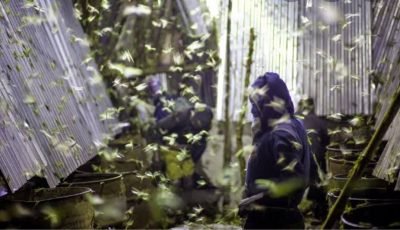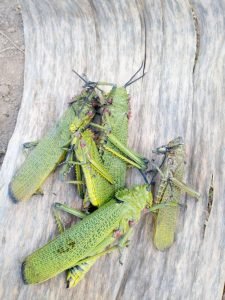Ugandans Feast and Trade

Whereas other countries in Africa are dreading the locust epidemic, Ugandans are looking forward to eating and selling them as they do ants and grasshoppers in Kampala. Insects are a source of income to Ugandans, and they come in specific seasons. The people of this region eat them fried, boiled, roasted, steamed among other recipes.

Meanwhile, locusts will suffer the same fate as hoppers since they are nutritious. Ugandans are already frying, boiling, roasting, and pounding the dried locusts into powder for consumption. Though they are hard to digest, the entrepreneurs are pounding them to powder. This powder is then sold to men for manhood enhancement and to women for vaginal fluid increment.

Ugandan officials rushed pesticides into affected regions. They have got thousands of soldiers deployed. Stephen Byantwale, the commissioner for crop safety at the Ministry of Agriculture, says: “We are using motorized sprayers, a drone, and manual spraying systems. The locusts spread rapidly, which makes them a clear, serious threat.”
Sadly, if the locust invasion was to be anticipated, they found none. The troops which the government deployed in Amudat, Northern Uganda, were on standby. They stood daily, day-in, day-out, but no locusts showed up. The locusts might have detected they’d be trapped and eaten in Uganda. So, they moved on to a different African country.
Locusts Evade East Africa
The last evasion was from 1987 to 1989. The recent major increase in locusts happened from 2003 to 2005. Six major epidemics have existed since the 1900s.

Huge swarms of locusts also entered Uganda and Tanzania, spreading across much of East Africa. In an already unstable country, they are threatening millions of agricultural land. In its northern border regions around Mount Kilimanjaro, Tanzania has observed swarms and hired three planes to spray pesticides. This technique is by far the most effective way to counterbalance the pest invasion.

When cyclones poured massive torrential rains into the Oman deserts, it produced the ideal conditions for locusts’ reproduction. The locusts came from the Arabian Peninsula. One particularly large swarm in north-east Kenya was about 40 km wide by 60 km long. A minimal swarm of locusts will eat enough food for 35000 people in a day.
South Sudan, where nearly half the country is facing starvation as it recovers from years of turmoil, has issues. Almost 20 million people in the eastern region, long threatened by frequent dry and floods, experienced high rates of food insecurity well before this epidemic.
The hazard in East Africa stems from the locust of the desert, one of a multitude of swarms-forming insects. East Africa’s epidemic has been the most severe in decades and has already destroyed crops across a region of Kenya and Somalia.
Locust Epidemic in Other Parts of Africa and the World

Climatologists have referred to unseasonal rains as a key factor in the epidemic, supported by a strong cyclone off Somalia in December. The outbreak from the Arab peninsula has also plagued India and Pakistan. Experts fear the percentage of locusts will increase by up to five hundred times by June if the dry climate is anticipated. This is contrary to the predicted continued showers in that area in the weeks to come. Although a direct connection is hard to establish, some observers attributed the locust epidemic to climatic change.
“We acknowledge cyclones are responsible for swarms. There has been a rise in cyclone frequency in the Indian Ocean over the past 10 years,” said Keith Cressman, the UN Food and Agriculture Organization (FAO) senior locust forecasting manager at the beginning of this month.
“There’s usually zero, or perhaps one. It’s unusual, therefore. But if this pattern of the growing cyclone levels persists in the Indian Ocean, it will certainly lead to an increase in locusts in the Horn of Africa.” It is a concern to link climate change directly to them.
The major concern is in the quasi-autonomous Puntland region of Somalia where several locusts are breeding. Al-Shabaab, the Islamic extremism party, is threatening most of the area. This poses more challenges when undertaking air spraying to kill the locusts. The region’s local officials said a unified swarm may produce up to 150 million locusts for each sq. km of agricultural land. Additionally, this is an area covering almost 250 fields.
MORE:












